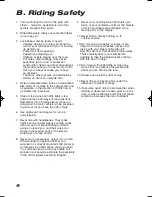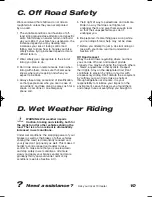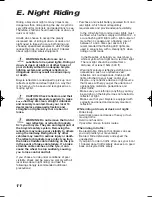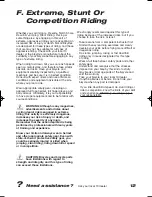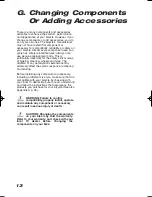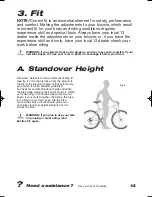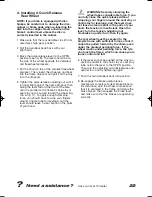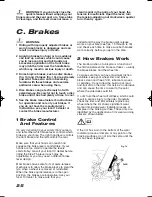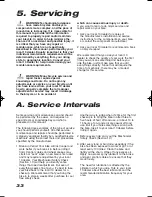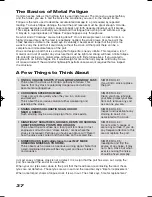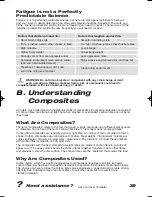
3 Removing And
Installing Bolt-On
Wheels
a. Removing A Bolt-On Front Wheel
1 If your bike has rim brakes, disengage the
brake’s quick-release mechanism to increase
the clearance between the tyre and the brake
blocks (see Section 4.C, figs. 14 through
to 18).
2 Using a correct size spanner, loosen the two
axle nuts.
3 If your front fork has a clip-on type secondary
retention device, disengage it and go to the
next step. If your front fork has an integral
secondary retention device, loosen the axle
nuts enough to allow wheel removal; then go
to the next step.
4 Raise the front wheel a few inches off the
ground and tap the top of the wheel with the
palm of your hand to knock the wheel out of
the fork ends.
b. Installing A Bolt-On Front Wheel
1 With the steering fork facing forward, insert
the wheel between the fork blades so that the
axle seats firmly at the top of the slots, which
are at the tips of the fork blades. The axle nut
washers should be on the outside, between
the fork blade and the axle nut. If your bike
has a clip-on type tab washer secondary
retention device, engage it
(see Section 4.A 1b).
2 While pushing the wheel firmly to the top of the
slots in the fork dropouts, and at the same
time centering the wheel rim in the fork, use
the correct size spanner to tighten the axle
nuts enough so that the wheel stays in place;
then use a spanner on each nut
simultaneously to fully tighten the nuts.
3 Re-engage the brake quick-release
mechanism to restore correct brake block-to-
rim clearance; spin the wheel to make sure
that it is centered in the frame and clears the
brake blocks; then squeeze the brake lever
and make sure that the brakes are operating
correctly.
c. Removing A Bolt-On Rear Wheel
WARNING: If your bike is equipped
with an internal gear rear hub, do not
attempt to remove the rear wheel. The
removal and re-installation of internal gear
hubs require special knowledge. Incorrect
removal or assembly can result in hub failure,
which can cause you to lose control and fall.
1 If your bike has rim brakes, disengage the
brake’s quick-release mechanism to open the
clearance between the tyre and the brake
blocks (see Section 4.C, figs. 14 through to 18).
2 Shift the rear derailleur to high gear (the
smallest rear sprocket) and pull the derailleur
body back with your right hand.
3 Using the correct size spanner, loosen the two
axle nuts.
4 Lift the rear wheel off the ground a few inches
and, with the derailleur still pulled back, push
the wheel forward and down until it comes out
of the rear dropouts.
d. Installing A Bolt-On Rear Wheel
1 Shift the rear derailleur to its outermost
position and pull the derailleur body back with
your right hand.
2 Put the chain on to the smallest sprocket.
Then, insert the wheel into the frame dropouts
and pull it up and back completely in to the
dropouts. The axle nut washers should be on
the outside, between the frame and the
axle nut.
3 Using the correct size spanner, tighten the axle
nuts enough so that the wheel stays in place;
then use a spanner on each nut
simultaneously to fully tighten the nuts.
4 Push the rear derailleur back into position.
5 Re-engage the brake quick-release
mechanism to restore correct brake
block-to-rim clearance; spin the wheel to make
sure that it is centered in the frame and clears
the brake blocks; then squeeze the brake
lever and make sure that the brakes are
operating correctly.
23
Fig. 12
open
13
owners manual GENERIC A5 aw
05/05/14
10:25 Page 25

